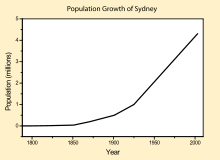- Demographics of Sydney
-
Sydney is Australia's most populous city, and is also the most populous city in Oceania. In the 2006 census 4,119,190 persons declared themselves as residents of the Sydney Statistical Division - about one-fifth (19.38%) of Australia's total population. If contiguous urban areas are considered, Sydney's population was 3,641,421 persons. Sydney is also the most densely populated city in Australia.
The median age of Sydney residents was 35 years, and households comprised an average of 2.7 members.
The officially estimated population for the Sydney Statistical Division at 30 June 2010 was 4,575,532.[1]
Contents
History
European settlement in Sydney began in 1788, and in 1800 Sydney had around 3,000 inhabitants. It took time for its population to grow - in 1851 its population was only 39,000, compared with 77,000 in Melbourne. The subsequent gold rushes in Victoria caused the population of Melbourne to increase rapidly, while the lesser gold rushes in New South Wales had a less profound effect on the population of Sydney.
Sydney
population by year1796 2,953 [2] 1911 629,503 [3] 1954 1,863,217 1961 2,183,231 1971 2,807,828 1981 3,204,696 1991 3,672,855 1996 3,881,136 2001 4,128,272 2006 4,281,988 2010 4,575,532 (Estimate)[4] 2026 5,426,300 (Projected)[5] 2056 6,976,800 Sydney overtook Melbourne as Australia's most populous city in the early twentieth century, and reached the million inhabitants milestone around 1925. The opening of the Sydney Harbour Bridge helped pave the way for further urban development north of Sydney Harbour. Post-war immigration and a baby boom helped the population reach two million by 1962. Sydney remained Australia's most populous city throughout the 20th Century, and is projected to retain this position for much of the 21st Century.[5]
Ethnic groups
Significant overseas born populations[6] Country of Birth Population (2006)  United Kingdom
United Kingdom175,166  People's Republic of China
People's Republic of China109,142  New Zealand
New Zealand81,064  Vietnam
Vietnam62,144  Lebanon
Lebanon54,502  India
India52,975  Philippines
Philippines52,087  Italy
Italy44,563  Hong Kong
Hong Kong36,866  South Korea
South Korea32,124  Greece
Greece32,021  South Africa
South Africa28,427  Fiji
Fiji26,928  Malaysia
Malaysia21,211  Indonesia
Indonesia20,562  Iraq
Iraq20,216  Germany
Germany19,364  Sri Lanka
Sri Lanka17,917  United States
United States16,340  Egypt
Egypt16,238  Croatia
Croatia15,501 At the 2006 census 39.4% of Sydney residents declared themselves to have been born overseas. The most common countries of birth outside Australia declared were the United Kingdom (4.3%), China (3.5%), New Zealand (2.0%), Vietnam (1.5%), India, The Philippines (about 1.3%), Lebanon (about 1.3%), and Italy (1.1%). Indigenous Australians were about 2% of all Sydney residents.
At the 2006 census respondents could nominate up to two ancestries they identified themselves.
The most common languages spoken at home are English (60.8%), Arabic (4.4%), Cantonese (3.4%), Mandarin (2.6%), Greek (2.2%) and Vietnamese (2.0%).[7]
Most common ancestries of
Sydney urban area (2006)[8]Population % Australian 999,000 27.4 English 840,118 23 Chinese 287,952 7.9 Irish 277,545 7.6 Scottish 202,938 5.6 Italian 157,765 4.3 Lebanese 125,257 3.4 Greek 106,003 2.9 Indian 90,944 2.5 German 86,721 2.4 Total population 3,641,424 Some suburbs are associated with particular ethnic groups:
- Indigenous Australians with Redfern
- Assyrians with City of Fairfield
- Bangladeshi with Hillsdale, Ingleburn, Lakemba, Minto and Rockdale
- Chinese with Haymarket, Cabramatta, Ashfield, Hurstville, Campsie, Chatswood, Eastwood, Epping, Carlingford, Parramatta, Burwood, Auburn, Artarmon and Fairfield [9]
- Croatians with Fairfield, Burwood, Liverpool, Kograh and Hurstville
- Greeks with Earlwood and Marrickville
- Indians with Westmead, Parramatta, Glenwood, Kellyville, Harris Park, Liverpool and Blacktown.
- Filipinos with Blacktown
- Japanese with Chatswood
- Jews with Bondi, Rose Bay, Bellevue Hill, Dover Heights, Vaucluse, Woollahra and St Ives
- Italians with Leichhardt and Bossley Park
- Koreans with Strathfield, Campsie, Chatswood, and Eastwood
- Pacific Islanders with Mount Druitt
- Lebanese with Lakemba, Campsie, Punchbowl, Merrylands, Auburn and Bankstown. Sydney has around 75% of Australia's Lebanese population.
- Macedonians with Rockdale, Kogarah
- Maltese with Greystanes, Horsley Park
- Portuguese with Petersham
- Serbians with Liverpool
- Spaniards with City of Fairfield
- Vietnamese with Cabramatta, Canley Vale, Fairfield, Bonnyrigg, Marrickville and Bankstown
The adjacent show concentrations of persons born in different regions of the world residing in particular parts of Sydney.
Religion
At the 2006 Census, the most common responses for religion were Catholic (29.2%), Anglican (16.5%), Eastern Orthodox (4.8%) and Islam (4.4%). 14.1% declared no religious affiliation.[7]
See also
References
- ^ "3218.0 – Regional Population Growth, Australia, 2009–10". Australian Bureau of Statistics. 31 March 2011. http://www.abs.gov.au/ausstats/abs@.nsf/Products/3218.0~2009-10~Main+Features~Main+Features?OpenDocument. Retrieved 31 March 2011.
- ^ "3105.0.65.001 - Australian Historical Population Statistics, 2006". Australian Bureau of Statistics. 23 May 2006. http://www.abs.gov.au/AUSSTATS/abs@.nsf/DetailsPage/3105.0.65.0012006?OpenDocument. Retrieved 21 November 2011.Table 1. Population by sex, states and territories, 31 December, 1788 onwards
- ^ "Australian Historical Population Statistics, 2008". Australian Bureau of Statistics. 5 August 2008. http://www.abs.gov.au/AUSSTATS/abs@.nsf/mf/3105.0.65.001. Retrieved 21 November 2011.
- ^ "3218.0 – Regional Population Growth, Australia, 2009–10". Australian Bureau of Statistics. 31 March 2011. http://www.abs.gov.au/ausstats/abs@.nsf/Products/3218.0~2009-10~Main+Features~Main+Features?OpenDocument. Retrieved 21 November 2011.
- ^ a b "3222.0 – Population Projections, Australia, 2006 to 2101". Australian Bureau of Statistics. 4 September 2008. http://www.abs.gov.au/Ausstats/abs@.nsf/mf/3222.0. Retrieved 21 November 2011.
- ^ Australian Bureau of Statistics (25 October 2007). "Community Profile Series : Sydney (Statistical Division)". 2006 Census of Population and Housing. http://www.censusdata.abs.gov.au/ABSNavigation/prenav/ProductSelect?newproducttype=Community+Profiles&collection=Census&period=2006&areacode=105&breadcrumb=LP¤taction=201&action=401. Retrieved 2008-02-28.
- ^ a b Australian Bureau of Statistics (25 October 2007). "Sydney (Urban Centre/Locality)". 2006 Census QuickStats. http://www.censusdata.abs.gov.au/ABSNavigation/prenav/LocationSearch?collection=Census&period=2006&areacode=UCL171400&producttype=QuickStats&breadcrumb=PL&action=401. Retrieved 23 November 2011. Map
- ^ "Cat. No. 2068.0 - 2006 Census Tables". Australian Bureau of Statistics. 2007. http://www.censusdata.abs.gov.au/ABSNavigation/download?format=xls&collection=Census&period=2006&productlabel=Ancestry%20(full%20classification%20list)%20by%20Sex&producttype=Census%20Tables&method=Place%20of%20Usual%20Residence&areacode=105. Retrieved 18 November 2011.
- ^ 1301.0 - Year Book Australia, 1995
Categories:- Sydney
- Demographics of Australia
- Demographics by city
Wikimedia Foundation. 2010.


